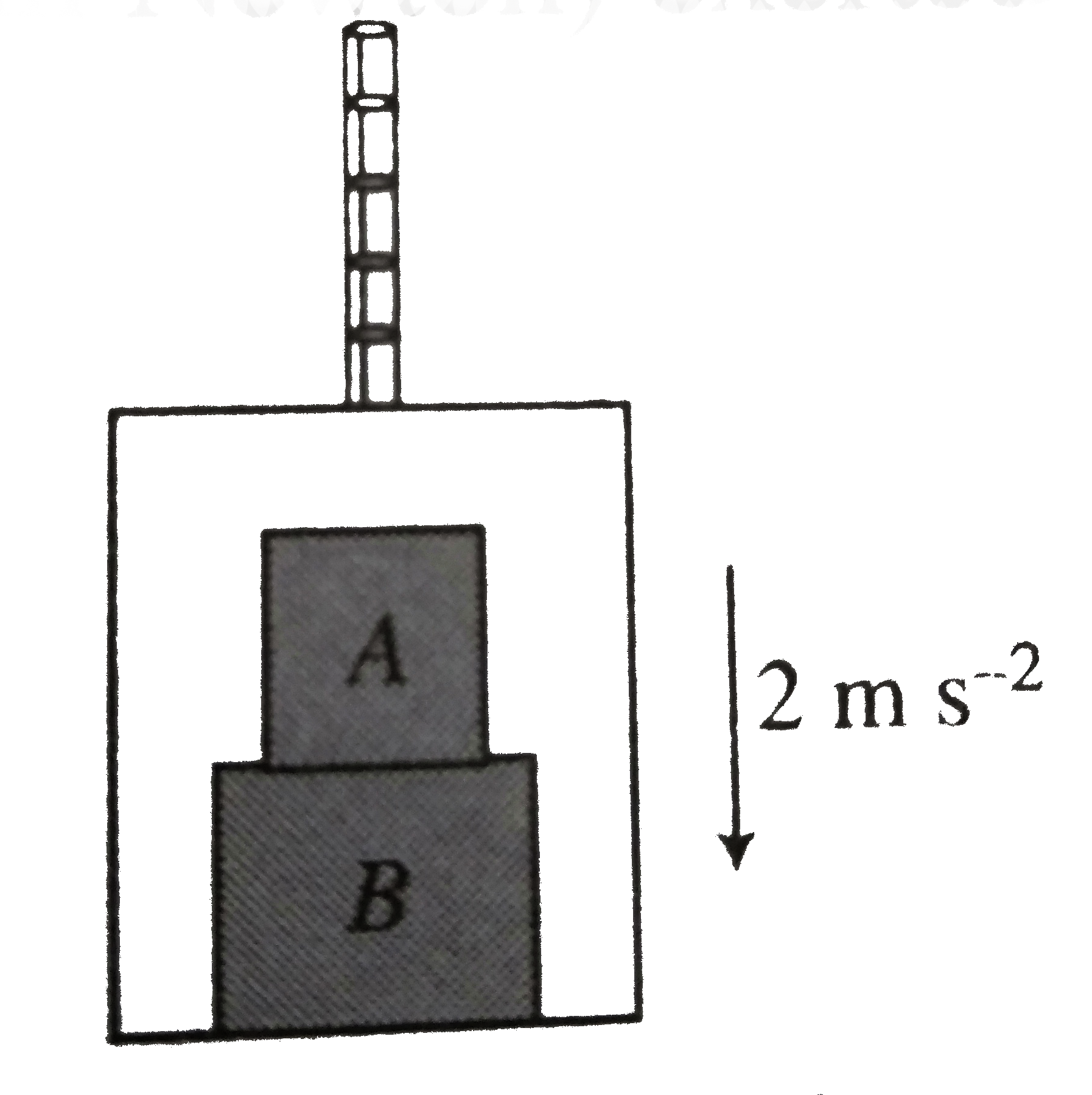A wooden block of mass 2 kg rests on a soft horizontal floor . When aniron cylinder of mass 25 kg is placed on top of the block , the floor yields steadily , and the block and the cylinder go down with an acceleration of What is the action of the block on the floor (a) before and (b) after the floor yields ? Take . Identify the action reaction pairs in the problem .
(a) The block is at rest on the floor . Its free-body diagram shows two forces on the block , the force of gravitational attraction by the earth equal to = 20 N , and the normal force R of the floor on the block . By the First law, the net force on the block must be zero i.e., R = 20 N. Using third law the action of the block (i.e, the force exerted to 20 N and directed the block ) is equal to 20 N and directed vertically downwards .
(b) The system (block + cylinder) accelerated downwards with 0.1 . The free-body diagram of the system shows two forces on the system : the force of gravity due to the earth (270 N) , and the normal force R' by the floor. Note the free-body diagram of the system does not show the internal forces between the block and the cylinder. Applying the second law to the system , brgt 270 - R' =
ie. R' = 267.3 N
By the third law , the action of the system on the floor is equal to 267.3 N vertically downward.
Action-reaction pairs
For (a) : (i) the force of gravity (20 N) on the block by the earth (say , action ) , the force of gravity on the earth by the block (reaction) equal to 20 N directed upwards ( not shown in the figure) .
(ii) the force on the floor by the block (action), the force on the block by the floor (reaction) .
Fig (b) : (i) the force of gravity (270 N) on the system by the earth (say, action) , the force of gravity on the earth by the system (reaction) , equal to 270 N ,

Topper's Solved these Questions
Similar Questions
A wooden block of mass 1 kg rests on a soft horizontal floor. When an iron cylinder of mass 20kg is placed on top of the block, the floor yields steadily and booth go down with an acceleration of 0.1ms−2. What is the action of the block on the floor (a) before and (b) after the floor yields? (Take g=10ms−2). Identify the action and reaction pairs in the problem.
 View Solution
View SolutionA steel block of 10 kg rests on a horizontal floor as shown. When three iron cylinders are placed on it as shown, the block and cylinders go down with an acceleration 0.2m/s2. The normal reaction R' by the floor if mass of the iron cylinders are equal and of 20 kg each, is ______ N. [Take g=10m/s2andμs=0.2]
 View Solution
View Solution
Knowledge Check
- Question 1 - Select One
Block A of mass 35 kg is resting on a frictionless floor.
 A0.8ms−2B2.4ms−2C0.4ms−2D4.4ms−2
A0.8ms−2B2.4ms−2C0.4ms−2D4.4ms−2 - Question 2 - Select One
On the floor of an elevator a block of mass 50 kg is placed on which another block of mass 20 kg is also placed. The elevator is moving up with a constant acceleration 1.5m/s2 Force exerted by 20 kg block on the 50 kg block is nearly:
 A250 NB230 NC170 ND150 N
A250 NB230 NC170 ND150 N - Question 3 - Select One
A block of mass 3kg is placed on a rough horizontal surface (μs=0.4) . A force of 8.7N is applied on the block. The force of friction between the block and floor is .
A8.7NB12NC10NDzero
.A block is kept on the floor of an elevator at rest.The elevator starts descending with an acceleration of 12m/s^(2) .Find the displacement of the block during the first 0*2safter the start.Take g=10m/s^(2)
View SolutionThe elevator shown in fig. is descending with an acceleration of 2ms−2. The mass of the block A=0.5kg. Find the force (in Newton) exerted by block A on block B.
 View Solution
View SolutionA block of mass 2 kg is placed on the floor (μ=0.4). A horizontal force of 7 N is applied on the block. The force of friction between the block & floor is fs. Find the fs.
View SolutionA block of mass 2 kg is kept on a rough horizontal floor an pulled with a force F. If the coefficient of friction is 0.5. then the minimum force required to move the block is :-
 View Solution
View SolutionOn the floor of an elevator a block of mass 50 kg is placed on which another block of mass 20 kg is also placed. The elevator is moving up with a constant acceleration 1.5m/s2 Force exerted by 20 kg block on the 50 kg block is nearly:
 View Solution
View Solution

